One of the best ways to reduce weight from your pack is to choose multi-purpose gear, such as tents that use your trekking poles for pitching instead of tent poles. Honestly though, a lot of trekking pole tents suck: they have issues like being difficult to pitch or condensation problems. Here are my picks for the best trekking pole tents (which are actually well designed!) plus what you need to know before buying.
Top Picks Overview:
- Best Overall: REI Flash Air 2P (Hybrid single wall; 40oz)
- Runner Up: Six Moon Designs Lunar Solo 1P (Hybrid single wall; 26oz)
- Best Budget Option: Mier Lanshan 2P -Double wall, 44.8oz
Comparison Table
| Tent | Sleeps | Walls | Weight | Floor area | Vestibules | Doors |
|---|---|---|---|---|---|---|
| Flash Air 1 | 1P | Hybrid 1 | 26oz | 21.3 sq ft | 1 | 1 |
| Six Moon Designs Lunar Solo Outfitter | 1P | Hybrid 1 | 26oz | 26 sq ft | 1 | 1 |
| Skyscape Trekker | 1P | Hybrid 1 | 28oz | 23 sq ft | 2 | 2 |
| Sierra Designs High Route 1P | 1P | 2 | 31oz | 16.6 sq ft | 2 | 1.5 |
| Mier Lanshan 1 | 1P | 2 | 35.2oz | 18.3 sq ft | 1 | 1 |
| Flash Air 2 | 2P | Hybrid 1 | 40oz | 28.7 sq ft | 2 | 2 |
| Featherstone Backbone 1 | 1P | Hybrid 1 | 44oz | 19 sq ft | 2 | 1 |
| Mier Lanshan 2 | 2P | 2 | 44.8oz | 26 sq ft | 2 | 2 |
| Six Moon Designs Lunar Duo Explorer | 2P | Hybrid 1 | 45oz | 34 sq ft | 2 | 2 |
| OneTigris Shelter | 2P | 1 | 51oz | 27 sq ft | 1 | 1 |
| Six Moon Designs Lunar Duo Outfitter | 2P | Hybrid 1 | 57oz | 34 sq ft | 2 | 2 |
| MSR Front Range | 4P | 2 | 63oz | 53.5 sq ft | 1 | 1 |
*Scroll down to read the full reviews and see all of the best trekking pole tents.
Want to really cut weight from your pack? Try dehydrating your own meals.
Some of my backpacking meals have over 150 calories per ounce, which means I can cut lots of weight from my pack without having to sacrifice flavor or nutrition. Just add water to rehydrate.
I’ve written all about it in my eBook. The book contains loads of info about backpacking meal planning plus over 50 recipes.
Get the eBook here. I’ll even give you 50% off 🙂
Best Trekking Pole Tents Reviewed
1. REI Flash Air (1p and 2p)
Best for: UL trekking tent which is easy to set up and withstands bad weather
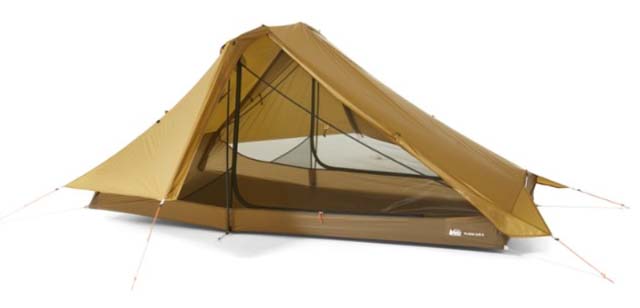
Features
- Capacity: 1P and 2P options
- Walls: Hybrid 1 wall
- Packaged Weight: 1lb 10.5oz (1P), 2lb 8oz (2P)
- Weight with own poles: 1lb 4oz (1P), 1lb 15oz (2P)
- Floor Material: Ripstop nylon
- Canopy: Nylon mesh
- Interior height: 42 inches
- Floor dimensions: 88×35” (1P), 88×52” (2P)
- Floor area: 21.3 sq. feet (1P), 31.7 sq. feet (2P)
- Vestibule: 8.4 sq. feet (1P), 2×8.4 sq. feet (2P)
- Setup: Two trekking poles plus vertical and foot pole
Review
If you are concerned about not being able to set up a trekking pole easily, then the REI Flash Air is a good choice. It comes with a 3.4oz pole which you or you can use trekking poles. There are also a small roof and vertical pole. The additional poles do add a tiny bit of weight but makes setup a heck of a lot easier. It takes all of 5 minutes to set up the Flash Air once you get the hang of it.
There are two versions of the REI Flash Air available: 1p and 2p. Both are suitable for tall people at 88 inches in length. The floor space is also roomier than other UL tents: 21.3 square feet for the 1P and 31.7 square feet for the 2P. That said, it’s still pretty tough to get two people in the 2P tent. Your pads will overlap and be prepared for close contact!
There are two doors and two vestibules on the 2P version of the Flash Air (the 1P only has one vestibule and 1 door). This makes it easier to get in/out of the tent and each person has gear storage space.
This is a hybrid single-wall tent and REI has added features to prevent condensation buildup. There’s mesh on the door/s and side wall. There are also three vents to improve airflow. You still won’t want to keep wet clothes in the tent and be careful where you pitch it, but it handles condensation better than other single-wall trekking pole tents.
As expected, there aren’t many extra features. However, there is a stash pocket and a lantern hook, which you don’t see on many UL tents.
Pros
- Easy to set up
- Very lightweight
- Lots of floor space
- Roomy vestibule
- Two doors on 2P version
- Withstands bad weather
- Suitable for tall people
- Good ventilation
Cons
- Footprint not included; adds weight
- Low ceiling height
- Pricy
2. Lunar Duo by Six Moon Designs
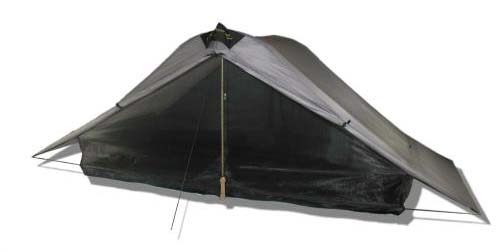
Best for: Incredibly spacious yet designed for serious hiking
Features
- Capacity: 1p & 2p
- Walls: Hybrid 1 wall
- Weight: 57oz
- Floor material: 30D silicon nylon
- Tarp material: 30D silicon nylon
- Inner material: 20D ultralight no see um
- Interior height: 45”
- Floor area: 34 sq. feet
- Vestibule: 2 x 12 sq. feet (24 sq. feet total)
- Setup: Two trekking poles + two spacer poles
Review
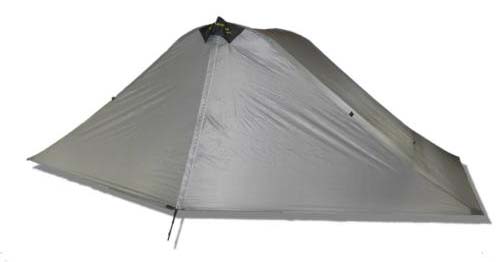
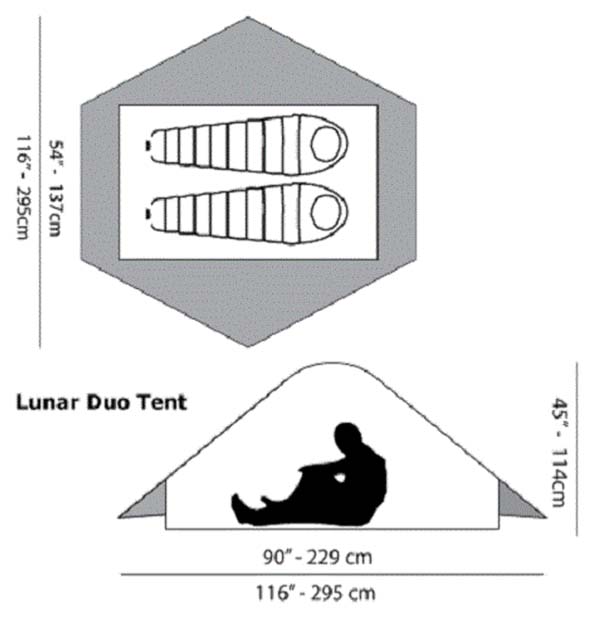
There are two versions of the Lunar by Six Moon Designs: the Explorer and Outfitter. The Explorer uses silnylon and the Outfitter uses PU-coated polyester. Silnyon is much lighter-weight, but also much more fragile (and expensive!). The Outfitter is available in 1p and 2p sizes.
The Lunar Duo uses two trekking poles plus two included spacer poles for setup. The spacer poles go above the doors and help keep the sides from slanting so much, so you end up with a lot more headroom.
Not only do you get lots of headroom with the Lunar Duo, but there’s also lots of floor space too. The tent is 54” across and 90” long. It will actually fit two people comfortably. Each of the two vestibules is 12 sq. feet, which means an additional 24 sq. feet of space for your gear (or your dog). The Solo version isn’t nearly as spacious and only has one vestibule.
There are a bunch of other nice features built into the tent, like the good ventilation, tension adjustments which make setting up easier, interior pockets and canopy which can be set to different heights. The only real issue with the tent is the high price tag. :/
Pros
- Two doors and vestibules
- Incredibly spacious with lots of headroom
- Vestibules are very large
- Easy setup
- Good ventilation
Cons
- UL Explorer version is pricy
- Pole is in middle of door entranceway
(also sometimes available here at Garage Grown Gear)
3. Six Moon Designs Skyscape Trekker 1P
Best for: Affordable but professional UL tent for solo hikers
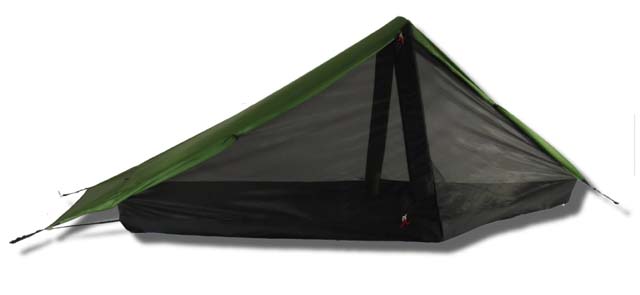
Features
- Capacity: 1P
- Walls: Hybrid 1 wall
- Weight: 1lb 12oz (doesn’t include stake weight)
- Canopy: 20D silicone-coated polyester 3000mm and 20D mesh
- Floor Material: 40D silicone polyester
- Interior height:
- Floor area: 23 sq. feet
- Vestibule: 2x8sq. feet (16 sq. feet total)
- Setup: Two trekking poles
Review
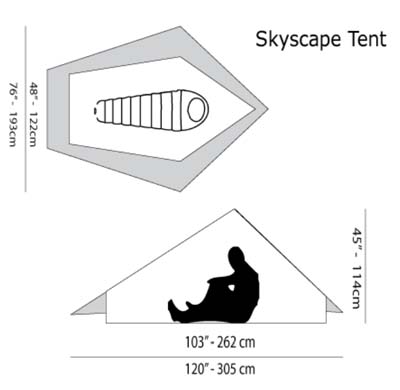
Six Moon Designs is a small company run by actual backpackers. Their products are made for long-distance thru hikes and are quickly becoming trail favorites. The Trekker 1P is a single-wall hybrid tent which has mesh sides. With both vestibules rolled up, you expose a lot of the mesh and can almost sleep under the stars. The feature is also great for added ventilation.
The listed tent floor space is very large. However, a lot of this space isn’t usable because of the low-ceilings near the foot of the tent. Regardless, it’s still a very roomy 1-person tent. The poles are off-set from each other to create a larger roof area. It’s over 8 feet long so definitely suitable for tall people.
Pros
- Lots of room for one person plus gear
- Two doors and two vestibules
- Suitable for tall people
- Good in bad weather
- Stash pocket
- Sturdy materials
Cons
- Poor ventilation when doors are completely closed
Get the tent here at Garage Grown Gear (also here on Amazon)
*There’s also a cheaper version of this tent called the Skyscape Scout.
4. Mier Lanshan Trekking Pole Tent (1p and 2p)
Best for: Great value and very functional
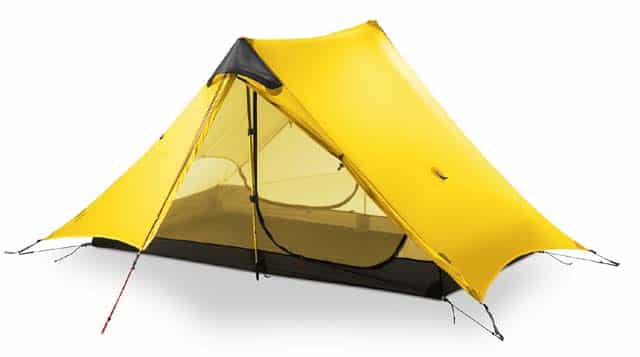
Features
- Capacity: 2P
- Walls: Double wall
- Weight: 3.3lbs – weight includes stakes
- Floor: 15D ripstop nylon; 6000mm
- Fly: 15D ripstop nylon, 5000mm
- Interior Height: 49”
- Size: 6.9×3.6’ (2p)
- Setup: 2 poles (2P)
Review
Considering that this is a cheap lightweight tent, it’s pretty damn impressive. Unlike most trekking pole tents, the Kikilive (previously known as the Mier tent) is two-layers with an inner mesh tent and an outer fly.
If you choose to camp with just the fly, you can get the weight down to about 1.5lbs. There are also some really nice features of the tent, like roomy vestibules. You’ll need the extra room of the vestibules though because the inside is such a tight fit.
There are also nice things like a lantern hanger, mesh pockets, and repair patch included. The materials seem to be high quality and reviewers say that it holds up in bad weather. Just note that the light weight is partially due to the fact that there’s no footprint. If you use your own footprint, it will add to the weight.
The triangle design means the tent can funnels rain away well. If you set it up with wind direction in mind, it will also hold up against tough storms. Getting in/out of the tent is a bit annoying because of the small door, but that’s just a minor gripe.
Pros
- Two-layer tent
- Very affordable
- 2 doors and 2 vestibules
- Inner mesh pockets
Cons
- Snug fit
- One way zipper on doors
- No footprint
- Heavy for trekking pole tent
5. Sierra Designs High Route 1FL Tent
Best for: Double-wall 1P UL tent with nice features like two doors and vestibules
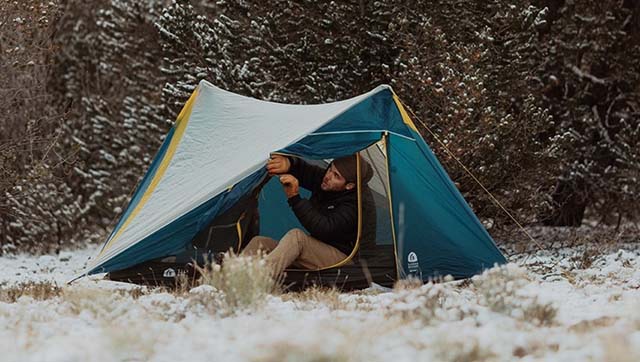
Features
- Packaged Weight: 1lb 15oz
- Walls: Double
- Fly Weight: 1lb 1oz
- Body Weight: 11oz
- Body Material: 15D nylon mesh
- Floor Material: 20D ripstop nylon DWR/1200mm
- Fly: 20D ripstop nylon, silicone/1200mm
- Interior height: 43” (nest), 48” (fly)
- Floor area: 16.6 sq. feet (nest), 29.8 sq. feet (fly)
- Vestibule: 7.3 sq. feet
- Setup: Two trekking poles
Review
At first, the High Route 1 trekking pole tent looks a bit weird. It is rectangular but the poles used to pitch the tent are offset from each other. This is actually a functionality feature: you can enter the tent without the poles blocking the doors. It also makes the tent more stable.
The two pole design creates an apex shape. This shape has more horizontal walls so you get more interior living space. There are technically 1.5 doors on the tent. While a small person could enter through the half door, it’s better used for ventilation or for accessing gear stored outside.
You’ll see the High Route tent listed as both a 1-person and 2-person tent. Both are true. This is because the tent consists of a fly and an inner nest. If you use just the fly (as a tarp tent), then you get much more interior space and it’s suitable for two people. When you use the nest, the living space is cut almost in half and it is only suitable for one person.
Compared to other trekking pole tents, this one is a bit finicky to set up. You’ve really got to make sure everything is tightened properly so it doesn’t sag. Once you master it, the tent does hold up against bad weather well. The 2-wall construction also means you don’t have to worry about condensation. Still, I wouldn’t recommend it for beginners.
My major criticism of the tent is that the vestibule is very small. It’s more of a covered awning than a vestibule. You can fit a backpack there, but don’t count on using the vestibule as living space during bad weather.
Pros
- Two-wall construction
- Can use fly by itself
- Good ventilation
- Lots of interior space
- Holds up in bad weather
Cons
- A bit trickier to set up
- Nest has very little floor area
- Vestibule is very small
- Pricy
6. Featherstone Backbone
Best for: One-person tent with lots of space and nice features, but heavier
Features
- Capacity: 1
- Walls: Single with hybrid doors
- Packaged Weight: 2lbs 6oz (min), 2lbs 12oz (packed)
- Floor material: 20D Sil-Nylon PU 2000mm
- Tent Material: 20D Sil-Nylon PU 2000mm
- Interior height: 47”
- Floor area: 19 sq. feet
- Vestibule: N/G
- Setup: Two trekking poles
Review
Featherstone is a newer brand making cheap ultralight gear. Their Backbone tent is far from ultralight, but it is one of the most spacious options you’ll find. The design means you get a lot of headroom and there are two vestibules for your gear (or a dog). The vestibules help with ventilation, so it’s a better choice for condensation.
The setup on the Featherstone Backbone is easier than with other trekking pole tents. There are reinforced pole pockets so you don’t have to worry about the poles tearing the fabric. The bottom guylines share the same hooks, so there are fewer tie-out points. That said, the double vestibule does mean you have a total of 8 tie outs to deal with.There are also some nice features, like a pockets, hooks and head vent. These aren’t things I’d expect on a cheaper tent.
Despite this, the Backbone tent is still pretty heavy. It’s design is almost identical to the Mier Lanshan 2p tent and they weigh almost the same, but the Lanshan 2p tent is much larger. For that reason, I’d spend a bit more to get the Lanshan instead of the Featherstone tent.
Pros
- Affordable
- Spacious and great headroom
- Two vestibules
- Easy setup
Cons
- 8 tie-outs
- Heavier option
7. OneTigris Trekking Pole Shelter
Best for: Affordable and spacious option, if you don’t mind some condensation
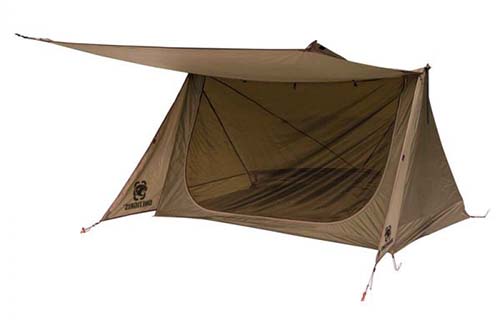
Features
- Capacity: 2
- Walls: Single with hybrid door
- Packaged Weight: 3lbs 3oz
- Floor material: N/G
- Tent Material: 75D Ripstop Nylon fabric 1500mm
- Interior height: 44”
- Floor area: 27 sq. feet
- Vestibule: 7 sq. feet
- Setup: Two trekking poles
Review
The OneTigris shelter is a single-wall trekking pole tent that sets up easily with two poles. You can also use branches or tie it to trees.
It has a double-wall door (mesh inner and separate fly). The vestibule only extends 13 inches out at the bottom, so you can barely fit your boots there. But the design allows you to set up the outer door like an awning. On nice nights, you can leave the awning open for ventilation.
In bad weather, the OneTigris holds up okay enough. The vents are at the bottom so some condensation is inevitable. However, the tent actually is spacious enough inside for two people. It’s just too bad that there is only one entrance – you’ll have to climb over your camping partner to get in/out. Also keep in mind that this is a generic Chinese brand. Quality and specs aren’t always consistent. I’ve seen different weights listed for this tent.
*OneTigris recently started making the Hillridge trekking pole tent. It’s lighter than this one but only partially-enclosed. Since I haven’t tried it myself and thhere aren’t many reviews, I don’t want to recommend it yet. But you can check it out here.
Pros
- Really affordable
- Spacious inside
- Door can be used as awning
- Large door
- Weight includes stakes
Cons
- Single side door
- Condensation
- Generic brand with inconsistent quality
8. MSR Front Range Shelter
Best for: Group backpacking if you don’t mind spending a fortune
Features
- Capacity: 4
- Walls: Double
- Packaged Weight: 3lbs 15oz (1lb 10oz tarp + 2lbs 5oz mesh)
- Floor material: 30D ripstop nylon 3000mm Xtreme Shield™ polyurethane & DWR
- Tent Material: 20-denier ripstop nylon/1,200 mm Xtreme Shield polyurethane and silicone
- Interior height: 56”
- Floor area: 53.5 sq. feet
- Vestibule: 30 sq. feet
- Setup: One 5-foot trekking pole
Review
The MSR Front Range shelter consists of two parts that you have to buy separately: a tarp shelter and a bug/floor insert. Warning that each item is expensive and the combo is VERY pricy. If you are a gear junkie, then you know MSR makes quality products. However, in this case, I don’t think that the cost is justified. The shelter lacks some basic features like pockets and there’s only one door.
True, you aren’t going to find any other trekking pole tents this large. But it’s not realistic for 4 people to actually sleep in this shelter. Since the pole is in the middle, someone is going to bump into it and possible knock the tent over. There’s also only one door, so people would have to crawl over each other to get in/out. Not fun!
That said, I haven’t been able to find any other trekking pole shelters this large. If you really need something this large, save yourself some money by just getting the bug insert and using it with a cheap tarp.
Pros
- Spacious with lots of headroom
- Easy setup
- Great quality
- Good ventilation
- Can use tarp by itself
Cons
- Only one door and vestibule
- Expensive
- Not realistic for 4 people to sleep inside
Pros and Cons of Trekking Pole Tents
The main reason hikers get trekking pole tents is to reduce weight from their pack. But, before you dive in with the goal of saving some ounces, make sure you carefully consider all of the pros and cons of trekking pole tents.
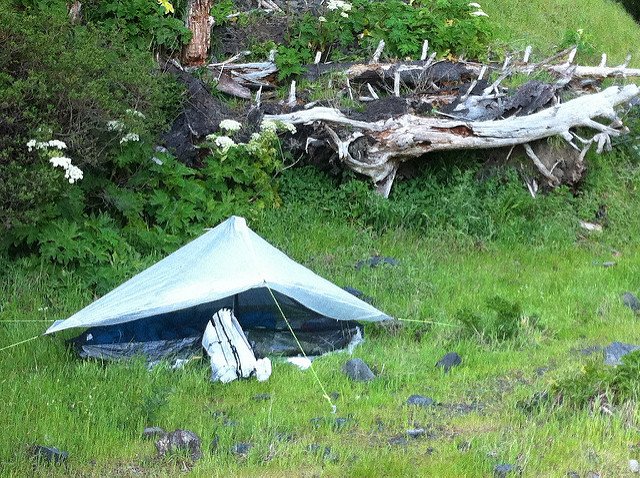
Pro: Reduce Weight
This is such a big benefit of trekking pole tents that it overrides almost all of the cons. While tent manufacturers have gotten better at making poles from ultralight materials, these still add weight. Plus, those ultralight poles will come at a cost.
Virtually all trekking pole tents are designed for ultralight backpackers, so they weigh in at under 2 pounds.
Pro: Cheap Ultralight Tent
Because they don’t come with poles, most trekking pole tents are significantly cheaper than lightweight tents. Some of the trekking pole tents listed here cost less than $100 and are still decent. If budget is your primary concern though, check out these cheap ultralight tents.
Pro: You Get a Free Tarp Tent
If you choose a double-wall trekking pole tent, you are basically getting a free tarp shelter. This gives you a lot of flexibility if you want to bring just the tarp/fly on some trips. Because tarp shelters can be surprisingly expensive, this will ultimately save you money.
Pro: You’ll Actually Bring Trekking Poles
A lot of hikers don’t bring trekking poles because of the extra weight. But, as I talk about in this post about the pros and cons of trekking poles, hiking with poles reduces a lot of strain on your knees and back.
If weight is the only thing that is keeping you from using trekking poles, then you should really consider getting a tent pitched with trekking poles. Your knees will thank you later on in life! (Not sure what size trekking poles you need? Montemlife’s trekking pole guide has a size chart based on your height!).
Con: Pitching Can Be a Pain
Trekking pole tents can be an absolute pain to pitch, especially if you can’t find a level campsite or the ground is rocky or sandy. Depending on how the tent is designed, you might spend a lot of time crouched on your knees adjusting guylines to get the tension right. If you don’t get the tent staked out right, it could start sagging. And the sagging might not happen until rain hits it in the middle of the night!
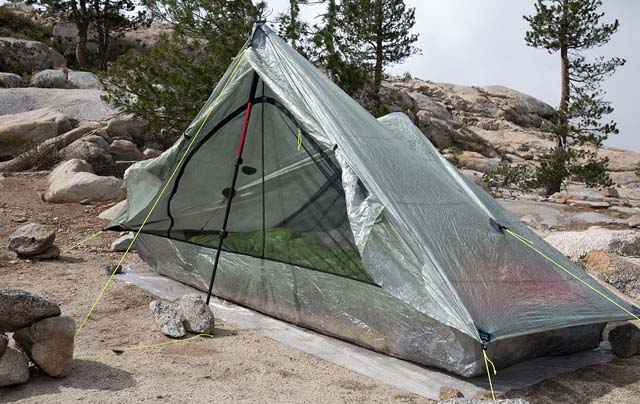
Check out all the rocks which had to be gathered to pitch this trekking pole tent (ZPacks Solplex)
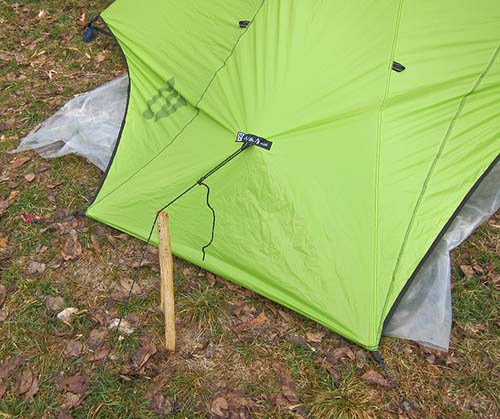
Look at what is invovled in pitching the Nemo Meta trekking pole tent (discontinued). It looks simple but actually takes some practice.
Con: Condensation
Since trekking pole tents are meant to be ultralight, many are single wall. To keep insects out, they often have mesh netting (aka hybrid wall).
Using a single wall can result in condensation, and you can’t open the doors for ventilation in bad weather. The good brands will put vents in their vents to prevent condensation but it’s still inevitable in bad weather.
Con: Risk of Puncture
Note that lots of trekking pole tents are designed so you put your pole upside down (tip point up). The idea is that the tip of the pole fits into a grommet. The handle side of the pole goes down in the ground.
If you aren’t careful when inserting the pole, it could slip out of the grommet and puncture the tent. This isn’t likely to happen, but is still something to be aware of.
Con: Pole Failure
In general, trekking poles are a lot more reliable than flimsy tent poles. However, your trekking poles get a lot more abuse than your tent poles. Over time, they can wear out. They might fail on you and not collapse/extend to the right size for your tent.
If you are going to get a trekking pole tent, make sure you have quality poles. Latch poles are more reliable than twist-type poles. You won’t have to worry about these slipping and causing your tent to sag.
Trekking Pole Tent vs. UL Freestanding Tent?
It the effort to go ultralight, it can be really tempting to choose a trekking pole tent. And I’m not trying to discourage you from them. However, be realistic. Is the extra hassle of pitching a trekking pole tent really worth the weight savings? Remember, going ultralight isn’t a competition. It’s about making the experience more enjoyable!
But there is one good reason to choose a trekking pole tent: Compared to UL freestanding tents, trekking pole tents are a lot more affordable. The Nemo Hornet UL 1P tent is freestanding and weighs just 2lbs, but it also costs about $360. By contrast, most trekking pole tents in that weight category don’t cost more than $100 to $200.
The bottom line? Choose a trekking pole tent if you have more experience pitching tents and want an UL tent which won’t cost a fortune.
Trekking Pole Tent vs. Tarp
If you are willing to put some extra effort into pitching in order to save weight, then it is worth considering a tarp shelter. A tarp shelter is almost always going to be lighter than a trekking pole tent, cheaper, and give you flexibility. If insects are going to be a problem, then you can bring a net shelter or bivvy to use under your tarp.
However, I wouldn’t go from a double-wall tent to a tarp right away. It takes a lot of learning and skill to backpack with a tarp. Sure, it might be easy when the weather is good — but what about when a storm suddenly hits and you are scrambling to find a proper pitch site?
One good piece of advice I read was this: It’s a lot easier to learn UL skills in a single-wall tent. Then you can move to a tarp system when it makes sense.
Trekking pole tents are a good transition between freestanding tents and a tarp. If you can’t decide between a trekking pole tent and a tarp, consider a double-wall trekking pole tent.Then you’ll have the option of just using the outer wall as a tarp tent later on.
Also read: 26 Tarp Shelter Configurations (with Pictures)
Do you use trekking poles to pitch your tent? Which tent and how do you like it?


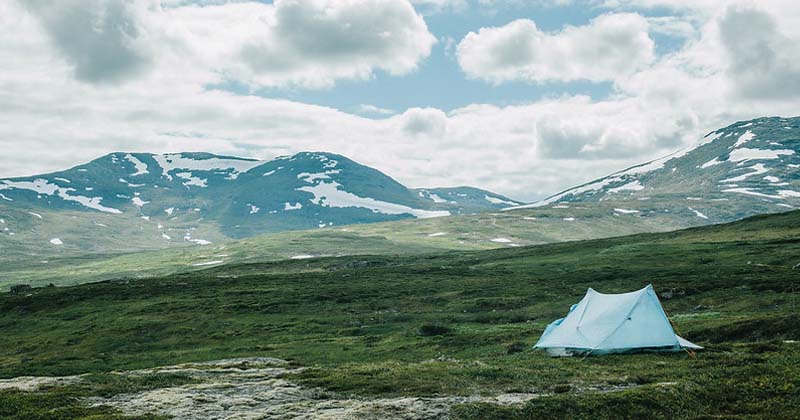
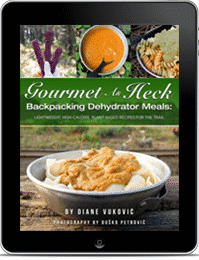
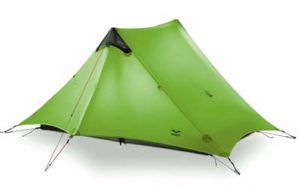
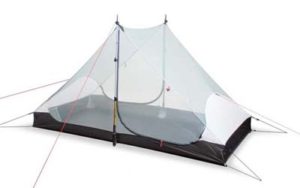
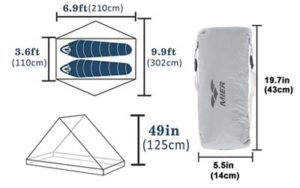
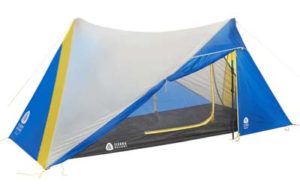

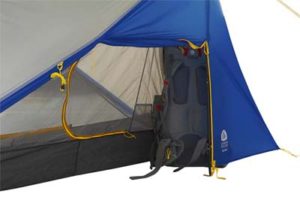
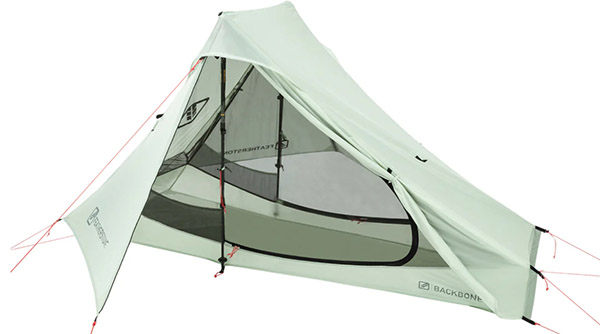
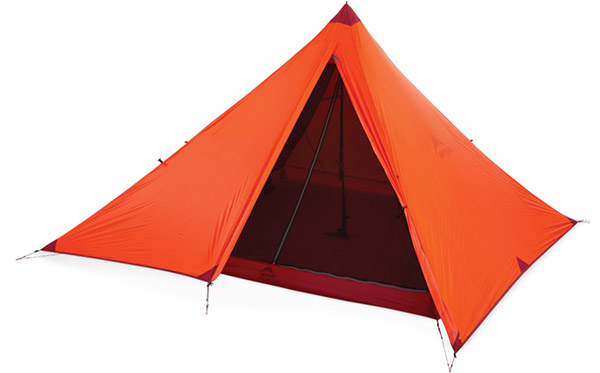
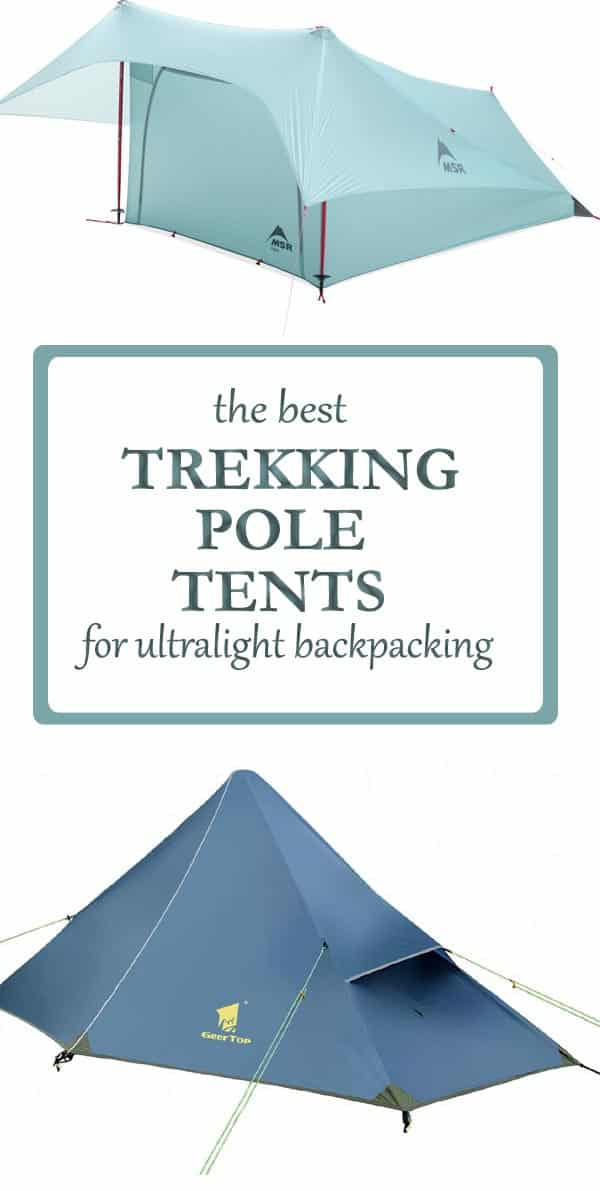

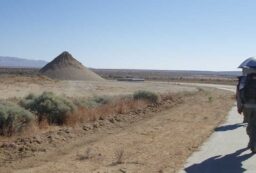








2 Comments
Paul McGrath
September 6, 2020 at 1:56 pmI’ve been using the Geertop pyrimid II at just 950g it’s a perfect size & weight for me, does suffer a bit with condensation though especially when there’s not much breeze. Although I have been very happy with this tent I’ve just ordered a new trekking pole tent from Toplander on AliExpress. Similar to the Rei tent but only £45 & weighing 1.2kg, 5000hh fly 8000 groundsheet. p.s soz about me email address, I used to play rugby very badly & got that as my nickname.
Diane
September 7, 2020 at 9:44 amMy family orders tons of stuff from AliExpress. The knockoff brands there are so much cheaper than what you’d find on REI or even Amazon. But it’s often hit-or-miss with quality and the product descriptions often have incorrect weight. Let us know how the Toplander turns out. 🙂